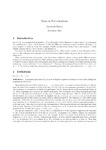| dc.rights.license | In Copyright | en_US |
| dc.creator | Ekenta, Onyebuchi (Onye) | |
| dc.date.accessioned | 2015-07-29T19:59:08Z | |
| dc.date.available | 2015-07-29T19:59:08Z | |
| dc.date.created | 2014 | |
| dc.identifier | WLURG38_Ekenta_MATH_2015 | |
| dc.identifier.uri | http://hdl.handle.net/11021/32171 | |
| dc.description | Thesis; [FULL-TEXT FREELY AVAILABLE ONLINE] | en_US |
| dc.description | Onyebuchi (Onye) Ekenta is a member of the Class of 2015 of Washington and Lee University. | en_US |
| dc.description.abstract | Runs in permutations and similar topics have been studied by various authors under different names. Hegarty examined permutations of finite abelian groups which avoid what he called progressions. Riordan studied 3-runs (which he called 3-sequences) and derived a formula to compute the number of permutations containing x 3-runs with rise of 1 and a distance of 1. Dymacek investigated 3-runs with d = 1 and r = 1 or r = 2. To our knowledge there has not been a formula produced for the cases where both r > 1 and d > 1. [From Introduction] | en_US |
| dc.format.extent | 12 pages | en_US |
| dc.language.iso | en_US | en_US |
| dc.rights | This material is made available for use in research, teaching, and private study, pursuant to U.S. Copyright law. The user assumes full responsibility for any use of the materials, including but not limited to, infringement of copyright and publication rights of reproduced materials. Any materials used should be fully credited with the source. | en_US |
| dc.rights.uri | http://rightsstatements.org/vocab/InC/1.0/ | en_US |
| dc.subject.other | Washington and Lee University -- Honors in Mathematics | en_US |
| dc.title | Permutation Formula (thesis) | en_US |
| dc.type | Text | en_US |
| dcterms.isPartOf | RG38 - Student Papers | |
| dc.rights.holder | Ekenta, Onyebuchi (Onye) | |
| dc.subject.fast | Permutations | en_US |
| dc.subject.fast | Series, Arithmetic | en_US |
| local.department | Mathematics | en_US |
| local.scholarshiptype | Honors Thesis | en_US |
